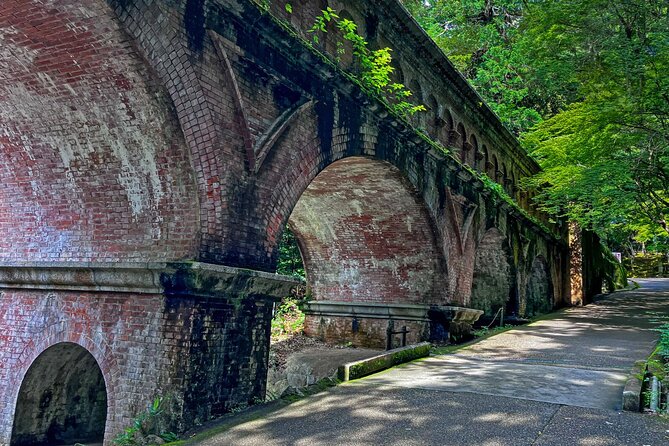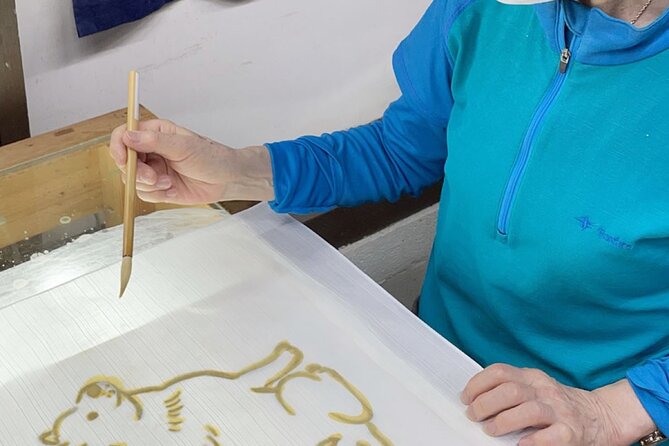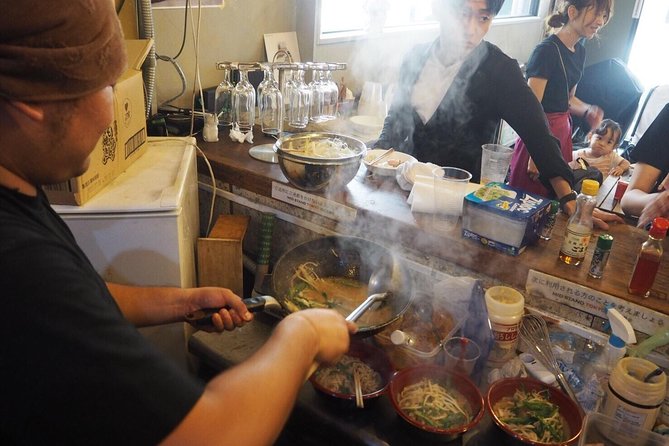Bamboo Artistry, Zen Serenity & With Ginkaku-Ji in Kyoto

Travelers seeking a serene escape in Kyoto can find inspiration in the artistry of bamboo. Imagine wandering through a labyrinth of green stalks, each one meticulously crafted into delicate masterpieces.
But the allure doesn’t end there; the harmonious blend of Zen serenity and the iconic Ginkaku-Ji temple adds a layer of cultural depth to the experience. As visitors explore this world of tranquility and artistry, they uncover a hidden gem that encapsulates the essence of Japanese beauty and craftsmanship.
Key Points

- Experience therapeutic benefits and crafted elegance in the tranquil Bamboo Grove.
- Immerse in Zen serenity and cultural significance at Ginkaku-ji Temple.
- Engage in traditional practices like the Tea Ceremony for harmony and respect.
- Explore historical and symbolic richness at Ginkaku-ji Temple, a symbol of Japan’s heritage.
It's also worth checking out some other tours and experiences nearby.
Ginkaku-ji Temple: History and Significance

Ginkaku-ji Temple holds a rich history and cultural significance in Kyoto, Japan. Its historical background dates back to the late 15th century when it was initially constructed as a retirement villa for Shogun Ashikaga Yoshimasa. Over time, it was transformed into a Zen temple following his death.
The temple’s understated elegance and simple beauty reflect the wabi-sabi aesthetic, emphasizing transience and imperfection. Ginkaku-ji, also known as the Silver Pavilion, stands as a symbol of Japan’s historical and architectural heritage.
Visitors can explore the temple grounds, featuring meticulously raked sand gardens, moss-covered pathways, and stunning views of Kyoto. The temple’s cultural significance lies in its embodiment of Zen Buddhism principles and its influence on Japanese art and garden design.
Bamboo Grove: Nature’s Serenity
Nestled within the surroundings of Kyoto, the Bamboo Grove offers visitors a tranquil retreat amidst nature’s serene beauty. Here, nature therapy and bamboo craftsmanship blend harmoniously, providing a calming atmosphere for all who wander through.
-
Peaceful Ambiance: The rustling bamboo leaves create a soothing soundtrack, perfect for relaxation.
-
Therapeutic Benefits: The fresh air and green surroundings offer a rejuvenating experience for mind and body.
-
Crafted Elegance: Witness the intricate bamboo craftsmanship in various forms, showcasing the skill of local artisans.
-
Natural Beauty: The tall bamboo stalks swaying gently in the wind create a picturesque landscape, ideal for peaceful contemplation.
-
Sensory Delight: Engage your senses with the earthy scent of bamboo and the sight of sunlight filtering through the dense foliage.
Zen Artistry: Cultural Reflections

Visitors at the Bamboo Grove in Kyoto can further enjoy Japanese culture by exploring the Zen artistry at Ginkaku-Ji, reflecting the essence of traditional craftsmanship and spiritual contemplation. Japanese aesthetics are intricately woven into the design of Ginkaku-Ji, showcasing the beauty of simplicity and tranquility. The meticulous attention to detail in every structure and garden area exemplifies the principles of traditional craftsmanship, emphasizing harmony with nature and the pursuit of inner peace. Through the Zen artistry at Ginkaku-Ji, visitors can experience a profound connection to the past and gain insights into the cultural significance of Japanese aesthetics. This cultural reflection invites contemplation and appreciation for the artistry that embodies the spirit of Zen philosophy.
| Japanese Aesthetics | Traditional Craftsmanship |
|---|---|
| Simplicity | Attention to Detail |
| Tranquility | Harmony with Nature |
| Contemplation | Pursuit of Inner Peace |
| Cultural Significance | Connection to the Past |
Tea Ceremony: Japanese Traditions

Enjoy the rich traditions of Japan by participating in a tea ceremony, a revered practice that embodies centuries-old customs and etiquette.
- Harmony: Japanese tea ceremonies focus on creating a harmonious environment.
- Respect: Participants show respect for the tea, the utensils, and each other.
- Tranquility: The ceremonies promote a sense of calm and tranquility.
- Attention to Detail: Every movement and gesture in the ceremony holds significance.
- Cultural Heritage: Engaging in a Japanese tea ceremony allows for a deeper understanding of the country’s cultural heritage.
Philosopher’s Walk: Tranquil Stroll

The serene Philosopher’s Walk offers visitors a tranquil stroll through Kyoto’s picturesque scenery, inviting contemplation and relaxation amidst nature’s beauty. Along this scenic path, visitors can engage in Zen meditation to find inner peace and harmony.
The gentle rustling of bamboo leaves and the soothing sound of the nearby stream create a peaceful atmosphere conducive to introspection. Plus, travelers can participate in a calligraphy workshop along the way, seeing the art of Japanese brushwork while surrounded by the beauty of the natural landscape.
The Philosopher’s Walk provides a serene escape from the hustle and bustle of the city, allowing visitors to connect with nature and find inspiration in the simplicity of the surroundings.
Silver Pavilion: Architectural Elegance

Nestled in Kyoto, the Silver Pavilion showcases exquisite architectural elegance that captivates visitors with its refined beauty. The tranquil surroundings of the Zen gardens further enhance the sense of serenity and contemplation at this historical site.
- Intricately designed wooden structures
- Delicate silver leaf embellishments
- Harmonious blend of nature and architecture
- Meticulously raked gravel patterns in the garden
- Serene atmosphere conducive to meditation
Kyoto Imperial Palace: Historical Landmark

Located in Kyoto, the Kyoto Imperial Palace stands as a significant historical landmark awaiting exploration by visitors. The palace holds immense historical significance as it served as the residence of the Imperial family until the capital moved to Tokyo in the 19th century.
Its architectural beauty reflects traditional Japanese design, with stunning gardens, meticulously crafted wooden structures, and serene courtyards. Visitors can enjoy the rich history of Japan as they walk through the corridors and observe the intricate details of the palace.
The Kyoto Imperial Palace offers a glimpse into the country’s imperial past and provides a peaceful retreat for those seeking to connect with Japan’s cultural heritage.
Nishiki Market: Culinary Delights

Visitors exploring the historical landmarks of Kyoto can continue their cultural journey by seeing the vibrant array of culinary delights at Nishiki Market. Nestled in the heart of Kyoto, this bustling market offers a feast for the senses with its local flavors and traditional dishes.
Here, visitors can savor fresh seafood, sample mouthwatering street foods, and indulge in sweet treats unique to the region. To delve deeper into Kyoto’s culinary scene, Nishiki Market also hosts culinary workshops where participants can learn the art of preparing authentic Japanese dishes.
Whether it’s trying new foods or honing cooking skills, Nishiki Market provides a taste of Kyoto’s rich gastronomic heritage.
- Fresh seafood from local waters
- Mouthwatering street food delicacies
- Unique sweet treats indigenous to Kyoto
- Interactive culinary workshops
- Traditional Japanese dish preparation
Frequently Asked Questions
Is There a Dress Code or Specific Attire Recommended for Participating in the Tea Ceremony?
For the tea ceremony, traditional attire enhances the cultural experience. Visitors should adhere to etiquette guidelines by wearing modest clothing. Comfortable yet respectful outfits are ideal. Embrace the tradition and immerse in the serene atmosphere.
Are There Any Restrictions on Taking Photographs or Videos Inside Ginkaku-Ji Temple?
Photography restrictions at Ginkaku-ji Temple may apply to certain areas. Visitors should adhere to cultural etiquette by respecting any signage or guidelines regarding photography. It’s important to be mindful and respectful of the sacred surroundings.
Can Visitors Participate in Any Hands-On Activities Related to Bamboo Artistry During the Tour?
Visitors can engage in hands-on bamboo artistry through bamboo crafting workshops and interactive bamboo activities during the tour. They can also witness bamboo art demonstrations, providing a unique and immersive experience.
Is There a Specific Time of Day When the Philosopher’s Walk Is Particularly Crowded With Tourists?
During peak hours, the Philosopher’s Walk can get crowded with travelers. Their behavior varies, some seeking quiet contemplation amidst the serenity, while others contribute to the hustle. It’s a mix of tranquil moments and bustling activity.
Are There Any Traditional Japanese Snacks or Dishes Recommended to Try at Nishiki Market for First-Time Visitors?
For first-time visitors at Nishiki Market, they should explore Japanese street food like takoyaki and yakitori for a cultural experience. Local delicacies such as matcha-flavored treats and fresh seafood offer a delightful culinary exploration in Kyoto.
Recap
Experience the essence of Kyoto’s beauty with Snow Monkey Resorts Tours.
From bamboo artistry to zen serenity, learn about the cultural treasures of Ginkaku-ji temple and beyond.
With a maximum of 20 travelers, this intimate tour offers a personalized exploration of Japan’s rich history and natural wonders.
Book now for a memorable adventure in the heart of Kyoto.


![NARA Walking Tour [Customize Your Itinerary]](https://tokyoezine.com/wp-content/uploads/1_nara-walking-tour-customize-your-itinerary.jpg)



